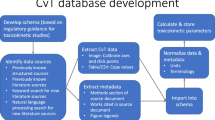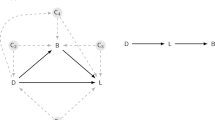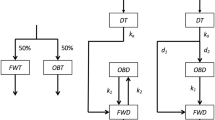Abstract
Quantitative description of the pharmacokinetics of dioxins and furans in humans can be of great help for the assessment of health risks posed by these compounds. To that the elimination rates of sixteen 2,3,7,8-chlorinated dibenzodioxins and dibenzofurans are estimated from both a longitudinal and a cross-sectional data set using the model of Van der Molen et al. [Van der Molen G.W., Kooijman S.A.L.M., and Slob W. A generic toxicokinetic model for persistent lipophilic compounds in humans: an application to TCDD. Fundam Appl Toxicol 1996: 31: 83–94]. In this model the elimination rate is given by the (constant) specific elimination rate multiplied with the ratio between the lipid weight of the liver and total body lipid weight. Body composition, body weight and intake are assumed to depend on age. The elimination rate is, therefore, not constant. For 49-year-old males, the elimination rate estimates range between 0.03 per year for 1,2,3,6,7,8-hexaCDF to 1.0 per year for octaCDF. The elimination rates of the most toxic congeners, 2,3,7,8-tetraCDD, 1,2,3,7,8-pentaCDD, and 2,3,4,7,8-pentaCDF, were estimated at 0.09, 0.06, and 0.07, respectively, based on the cross-sectional data, and 0.11, 0.09, and 0.09 based on the longitudinal data. The elimination rates of dioxins decrease with age between 0.0011 per year for 1,2,3,6,7,8-hexaCDD and 0.0035 per year for 1,2,3,4,6,7,8-heptaCDD. For furans the average decrease is 0.0033 per year. The elimination rates were estimated both from a longitudinal and a cross-sectional data set, and agreed quite well with each other, after taking account of historical changes in average intake levels.
This is a preview of subscription content, access via your institution
Access options
Subscribe to this journal
Receive 6 print issues and online access
$259.00 per year
only $43.17 per issue
Buy this article
- Purchase on Springer Link
- Instant access to full article PDF
Prices may be subject to local taxes which are calculated during checkout
Similar content being viewed by others
Author information
Authors and Affiliations
Corresponding author
Rights and permissions
About this article
Cite this article
VAN DER MOLEN, G., KOOIJMAN, B., WITTSIEPE, J. et al. Estimation of dioxin and furan elimination rates with a pharmacokinetic model. J Expo Sci Environ Epidemiol 10, 579–585 (2000). https://doi.org/10.1038/sj.jea.7500140
Received:
Accepted:
Published:
Issue Date:
DOI: https://doi.org/10.1038/sj.jea.7500140
Keywords
This article is cited by
-
A review of persistent organic pollutants: dioxins, furans, and their associated nitrogenated analogues
SN Applied Sciences (2020)
-
PCBs and PCDD/FS in Fish and Fish Products and Their Impact on the Human Body Burden in Belgium
Archives of Environmental Contamination and Toxicology (2007)



